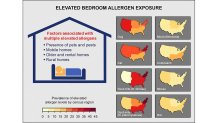What to Know
- The nation's largest indoor allergen study ever has found the majority of U.S. homes have three or more detectable allergens
- Allergens can lead to health problems like asthma and allergies
- Dust mite and pet allergens were largely prevalent in the Northeast homes, especially in rural areas
A vast majority of U.S. homes have significant levels of allergens, and homes in the Northeast are among the worst in the nation for certain types of allergens, according to the nation’s largest indoor allergen study to date.
The study looked at eight common allergens — cat, dog, cockroach, mouse, rat, mold, and two types of dust mite allergens — and their prevalence in 7,000 bedrooms across the country.
The findings, published Nov. 30 in the Journal of Allergy and Clinical Immunology, show bedrooms in the Northeast, as well as the South, are among the worst in the nation for different types of dust mite allergens. The Northeast is also the worst for cat allergens and among the worst for dog allergens, the study found.

Exposure to allergens was more likely in rural areas and in mobile homes, older homes and rental homes, according to the study. While people in urbanized areas were less exposed to allergens, they were more likely to have immune systems that overreacted to the allergens, a factor called “sensitization.”
Exposure levels also varied greatly by age, sex, race, ethnicity and socioeconomic status. For example, males and non-Hispanic blacks were less likely to be exposed to multiple allergens, but those groups also had higher rates of sensitization, according to the study.
Overall, more than 90 percent of U.S. homes studied had three or more detectable allergens, and 73 percent of homes had at least one allergen at elevated levels. Not surprisingly, the study found the presence of pets and pests had a major influence on high levels of allergens.
Local
Here are some things you can do to reduce your exposure to indoor allergens and irritants:
• Vacuum carpets and upholstered furniture every week.
• Wash sheets and blankets in hot water every week.
• Encase mattresses, pillows, and box springs in allergen-impermeable covers.
• Lower indoor humidity levels below 50 percent.
• Remove pets from homes or at least limit their access to bedrooms.
• Seal entry points and eliminate nesting places for pests, and remove their food and water sources.



